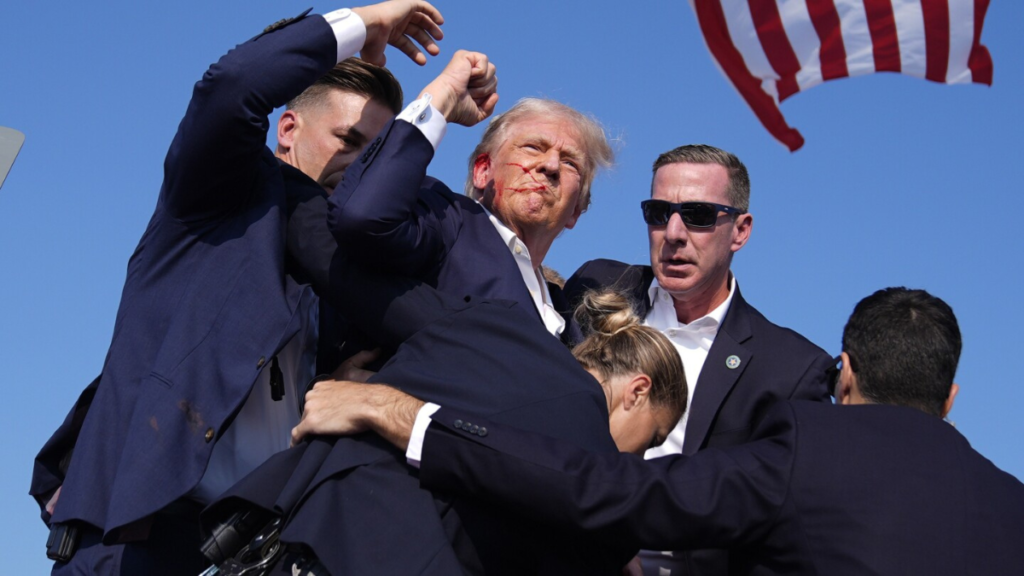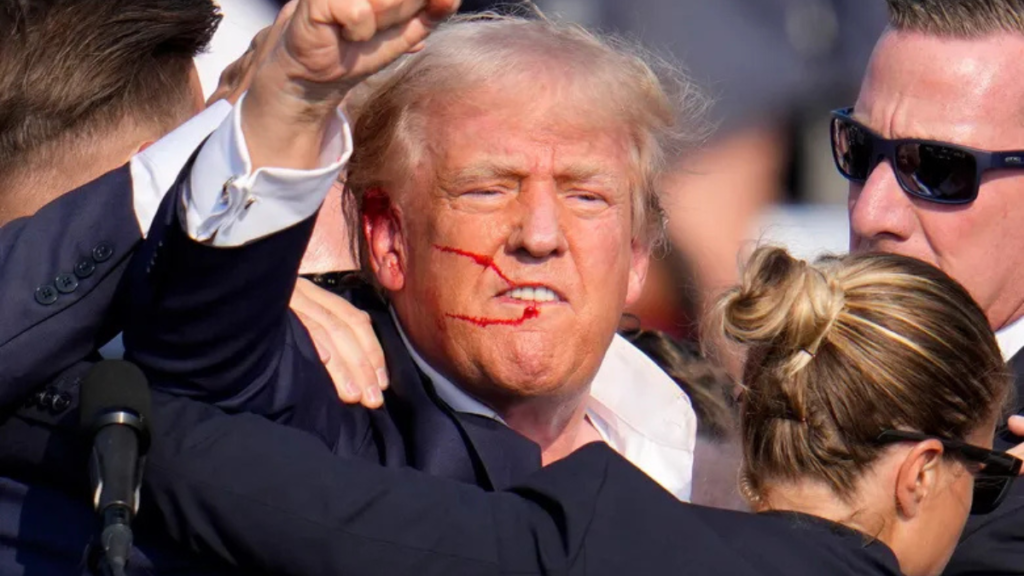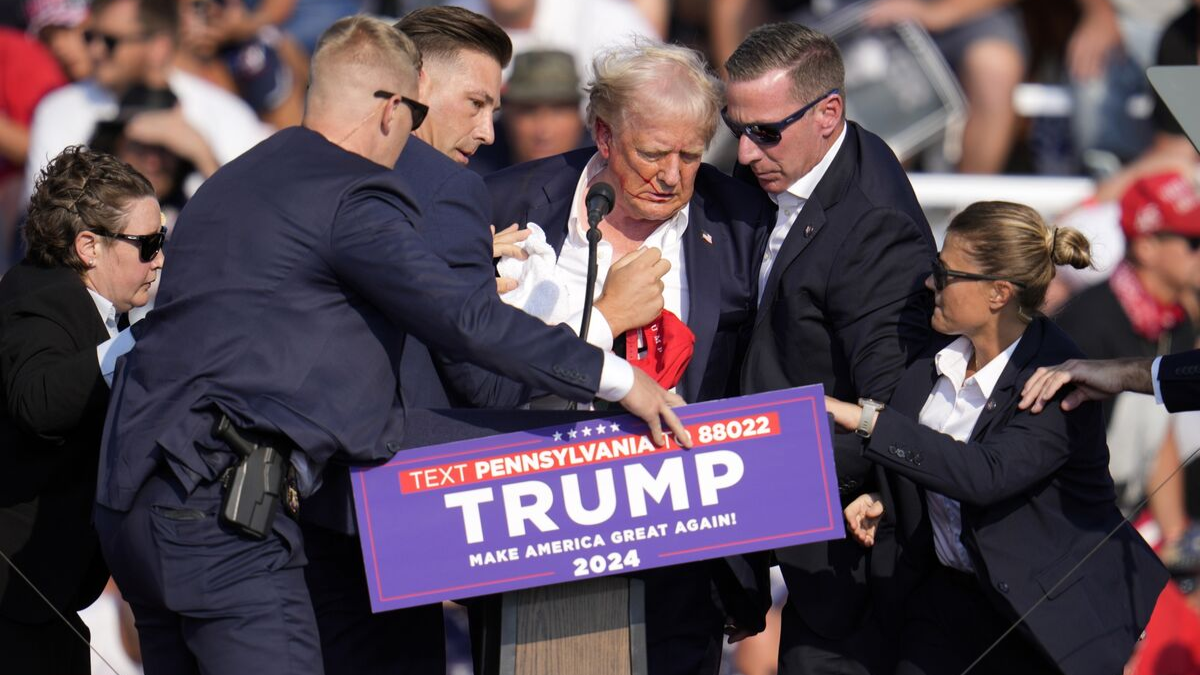In today’s digital era, misinformation spreads rapidly, often amplifying false narratives that can mislead the public. One recent example is the online claim that former President Donald Trump was shot in the chest and saved by a bulletproof vest. This claim circulated through social media platforms, accompanied by a photo that appeared to support this narrative. However, this assertion is untrue, and the story behind it serves as a crucial reminder of the importance of verifying information before believing or sharing it.
This article aims to clarify the truth behind the photo and explore the impact of misinformation Trump shot, especially in politically charged contexts. By examining the origins of the claim, the nature of misinformation, and how readers can identify credible sources, we hope to foster a more informed, discerning audience.
The Misleading Claim: Trump and the Bulletproof Vest Photo

Social media platforms are fertile ground for viral content, but not everything that goes viral is factual. The recent claim that Donald Trump shot was shot in the chest and saved by a bulletproof vest started with an image circulating widely on Facebook, Twitter, and Instagram. The image featuredTrump shot wearing what appeared to be a bulky vest under his clothing, sparking assumptions and speculations about his safety and security.
The story gained traction quickly, primarily because of Trump’s prominence and the heightened political climate surrounding him. Rumors about politicians facing attacks or threats can gain momentum easily, particularly when individuals see images that seem to support these ideas. However, fact-checking reveals that this specific story is entirely baseless.
The Origin of the Photo
The viral photo in question does indeed show Donald Trump, but it has been misinterpreted and misrepresented. The image was taken during one of Trump’s public appearances, where he may have been wearing additional protective layers or clothing that appeared bulky. These types of images are not uncommon and are often the result of simple clothing choices rather than specialized protection.
The fact-checking website Snopes quickly debunked the claim, identifying that the picture shows no evidence of a bulletproof vest nor of any recent attempt on Trump’s life. This image likely captured a moment where the fit of his clothing created an illusion of bulkiness, leading viewers to jump to conclusions that simply weren’t true.
Fact-Checking Platforms: How They Uncover the Truth
Organizations such as Snopes, FactCheck.org, and PolitiFact have dedicated resources to investigating claims that quickly spiral out of control online. In this case, they identified the photograph’s context, verified that no incidents involving Trump shot being shot were reported, and refuted the claim. Fact-checking organizations play a pivotal role in combating misinformation by providing the public with accurate information about controversial or sensationalized stories.
These platforms conduct rigorous investigations by:
Analyzing original sources:
They locate the earliest appearances of an image, video, or claim and compare it to the context provided in the viral version.
Cross-referencing credible reports:
Fact-checkers often contact officials or refer to trusted news outlets to confirm whether events actually happened.
Examining digital traces:
Using digital forensic tools, they can verify the authenticity of images and videos, detecting signs of manipulation.
Why People Believe Misinformation
The belief in misinformation stems from several psychological and societal factors. The rapid nature of social media sharing creates a confirmation bias, where people are more likely to believe information that aligns with their pre-existing views. If someone already perceives that political figures like Trump are frequent targets of violence, a story about an attempted assassination, even if false, feels plausible.
Moreover, the sensational nature of such a story—claiming an attack on a prominent figure—creates an emotional response that overrides rational skepticism. Research shows that misinformation often appeals to people’s emotions, leading them to react without fact-checking. When content is shared among online groups or communities with similar political leanings, it gains further legitimacy, becoming difficult to disprove.
The Role of Visual Misinformation: How Images Shape False Narratives
Images and videos are especially powerful in shaping opinions, as they evoke strong, immediate reactions. Visual misinformation is common because many people tend to trust what they see. When people come across an image that appears to depict a significant event, they may believe it before questioning its accuracy. In this case, the photo showing Trump shot in a seemingly padded outfit fueled the belief that he had been involved in an attack and survived due to protective gear.
Deepfakes and altered images can take this one step further, creating entirely fabricated scenes that appear realistic. As digital manipulation technology improves, the public needs to become more skeptical of images and videos that spread on social media, particularly when used to support sensational claims.
The Dangers of Political Misinformation
Misinformation around political figures can have serious repercussions, affecting public opinion and even leading to acts of violence. In recent years, several instances have shown how false claims can mobilize groups, encourage hostility, and foster division. Stories that falsely depict politicians as being under attack may deepen partisan divides as supporters and opponents interpret the misinformation to fit their own agendas.
Moreover, false claims about threats or attacks on political figures can create unnecessary fear and heighten distrust among the public. When people continuously encounter misinformation, it erodes trust in reliable news sources and makes it difficult for individuals to discern fact from fiction.
Steps Social Media Platforms are Taking to Counter Misinformation
Recognizing the scope and impact of misinformation, social media platforms like Facebook, Twitter, and Instagram have introduced several measures aimed at reducing its spread. These include:
Fact-checking partnerships:
Platforms collaborate with third-party fact-checkers to label false information.
Content warnings:
Users may see a warning or flag when attempting to share a post that has been identified as misleading.
Reducing reach:
When content is flagged, social media algorithms may limit its visibility to prevent further spread.
User education:
Some platforms have started campaigns to educate users about identifying credible information and spotting misleading content.
Despite these efforts, misinformation persists, partly due to the speed at which content spreads and the reluctance of some users to verify claims before sharing.
How to Identify Reliable Information and Avoid Misinformation
Becoming media literate is essential to combating the influence of misinformation. Here are a few key steps readers can take to ensure they are accessing reliable information:
Cross-check sources:
Always verify information from multiple reputable sources. Reliable news organizations provide context and are less likely to sensationalize events.
Look for fact-checks:
If a story seems implausible or sensational, check trusted fact-checking websites for verification.
Question emotional content:
If a post triggers an immediate emotional response, it may have been crafted to manipulate that reaction. Take a step back before sharing.
Analyze visuals carefully:
Be cautious about images that seem to confirm an extraordinary claim without additional evidence. Images and videos can be easily altered or taken out of context.
Engage in responsible sharing:
Before sharing content, consider its credibility and the impact it might have on others. Sharing only verified information helps reduce the spread of misinformation.
FAQs

Q: Was Donald Trump actually shot?
A: Yes, Donald Trump shot was injured during a campaign rally in Pennsylvania in July 2024. The bullet grazed his right ear, causing a superficial injury that required medical attention. He was treated at Butler Medical Center and quickly resumed public appearances afterward.
Q: Who was responsible for the shooting incident?
A: The shooter was identified as Thomas Matthew Crooks, a 20-year-old from Pennsylvania, who fired multiple rounds. He was quickly neutralized by Secret Service agents after the attack. The motive behind the attack is still under investigation by the FBI, though there is no confirmed connection to any broader conspiracy at this time.
Q: Was Trump wearing a bulletproof vest?
A: There’s no verified information indicating Trump was wearing a bulletproof vest during this event. He was escorted from the stage by Secret Service agents after being injured.
Q: Why did misinformation spread about Trump’s injuries?
A: Social media posts have circulated unfounded claims that Trump’s injury was either faked or staged. The Secret Service and eyewitness videos confirm he was quickly surrounded by security and escorted offstage. Conspiracy theories about the event continue to circulate, but there’s no evidence supporting these claims.
Q: How did the Secret Service respond during the incident?
A: The Secret Service quickly intervened, surrounding Trump within seconds and escorting him off the stage. Their swift actions were credited with preventing further harm. However, the incident raised concerns over security measures, leading to increased scrutiny and a subsequent resignation of the Secret Service director.
Q: What additional security measures are in place after the incident?
A: Following this incident, the Secret Service heightened security for Trump’s rallies, including the potential use of bulletproof glass at events. This aims to prevent similar threats in the future, especially as Trump is a prominent figure in the upcoming election.
Q: Where can I find reliable information about this incident?
A: For factual updates, consult verified news sources like FactCheck.org, the Associated Press, or major news outlets. These sources provide updated details as the investigation progresses and help clarify misinformation.
Conclusion
The false claim that Donald Trump shot was in the chest and saved by a bulletproof vest is just one example of how misinformation spreads online, often creating confusion and unnecessary alarm. Fact-checking platforms and responsible journalism play a vital role in dispelling these myths, but individuals also have the responsibility to approach content critically.
In an age where information moves at an unprecedented speed, vigilance and media literacy are more crucial than ever. By fostering a discerning audience, we can work collectively to reduce the influence of misinformation and build a society that values truth and transparency.

